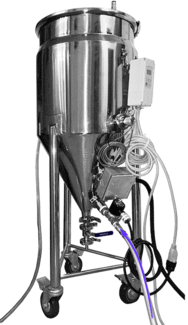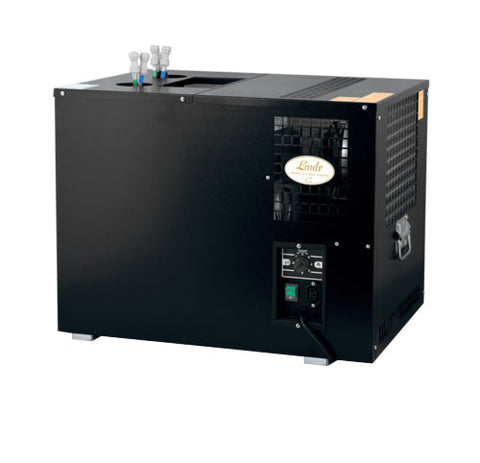Maintaining Low Fermentation Temperatures Without a Fridge
Controlling temperature during fermentation is very important for best flavor and batch-to-batch consistency. Sometimes, small breweries will control fermentation temperatures by regulating the room temperature or placing their fermenter in an old fridge that can be turned on and off. While these methods work, they have several drawbacks including:
- energy inefficient (heating or cooling an entire room)
- imprecise (temperatures in the fermenter can climb several degrees above the room temperature during active fermentation as air is not a great conductor of heat)
- bulky (a large fridge gets in the way)
- awkward (moving fermentation vessels in and out of coolers can be difficult)
 BREWHA's jacketed fermetners (3-in-1 and 4-in-1) provides a simple solution. By passing a warming or cooling/chilling liquid through the jacket, the temperature in the fermenter can be maintained at a precise point, providing perfect conditions for yeast, ensuring highest beer quality.
BREWHA's jacketed fermetners (3-in-1 and 4-in-1) provides a simple solution. By passing a warming or cooling/chilling liquid through the jacket, the temperature in the fermenter can be maintained at a precise point, providing perfect conditions for yeast, ensuring highest beer quality.
In many locations the fermenter temperature can be maintained by just passing municipal water through the jacket. As the ETC senses the fermenter warming up, it sends a signal to open the Temperature Control Valve (TCV), letting cooling water into the jacket. When the temperature drops back to the set point on the ETC, it closes the TCV and stops the cooling water.
In some areas, however, the municipal water is too warm to properly chill the fermenter or will consume too much water. In this situation there are a few options:
- A glycol chiller which requires that glycol be added to the water being used as a chillant. The glycol added to the water (usually at around 30%) prevents the water from freezing as it passes through the chiller. Glycol is a less efficient transporter of heat, is expensive to use, messy to work with, and requires constant vigilance (to ensure concentration in water is sufficiently high). It's only benefit is that it allows the water to be cooled below freezing which allows brewers to crash their beer a degree or two colder.
- BREWHA's Water, Beer and Wort Chiller. These chillers use the exact same chilling principle as glycol chillers (on the compressor side) but using a water bath for cooling the water (instead of an enclosed heat exchanger) the dangers caused by icing up are greatly reduced. (Note: some customers are confused about the difference between a glycol chiller and our chillers—if glycol were added to the water bath, and the internal thermostat adjusted to go colder, they work effectively identical to a glycol chiller.) One of the major benefits of our chillers is that when crashing beer they can be used in conjunction with municipal or well water to bring the wort temperature down from boiling (since the chiller just uses water anyways, interchanging with tap water will not dilute the glycol). The municipal/well water is used to do the lion share of the work (e.g. bring temperature from 212F to ~80F) and then switch to the Lindr chiller for the remainder. (Note: the temperature of the water bath should always be kept below 30C/90F. The chiller alone should not be used to cool a large volume of boiled wort or it will raise the temperature in the water bath above 30C/90F.) Municipal water is very efficient when the temperature difference between wort and chilling water is high, but not efficient when the difference is small. For example, approximately 30% of municipal water is used to bring temperature down 70% of the way, and 70% of water is used to bring temperature down the last 30%. So the least amount of water can be used by employing a chiller to do the last bit of work. A extra benefit of these chillers are that they have their own pump (glycol chillers most often do no).
-
 Our chillers have a 38L/10USG reservoir, however, if a larger reservoir of cold water (cold liquor tank) is needed (for example, if tap water is above 10C/50F so cannot efficiently complete post-boil knock down, or if a customer wants to minimize the use of tap water), a secondary vessel can be used to store cold water (by using the Chiller to cool it down ahead of time) so it is ready for use on brew day. It can also be used to maintain temperature during fermentation. By connecting the Chiller water pump to the inlet of the fermenter jacket, and the exit of the jacket back to the Chiller reservoir, and by using the ETC to turn the Chiller pump on and off cooling water can be pumped into the jacket whenever needed. As always, to minimize temperature creep away from the chilling set point, it is best to keep the chillant temperature (cold water in this situation) relatively close to the temperature of the fermenting wort. If there is a high temperature difference (ie. the chillant is really cold), when the pump shuts off, the remaining cold water in the jacket will continue to chill the wort for a little while, dropping the temperature further than intended (and creating a vacuum inside as the beer and air contract).
Our chillers have a 38L/10USG reservoir, however, if a larger reservoir of cold water (cold liquor tank) is needed (for example, if tap water is above 10C/50F so cannot efficiently complete post-boil knock down, or if a customer wants to minimize the use of tap water), a secondary vessel can be used to store cold water (by using the Chiller to cool it down ahead of time) so it is ready for use on brew day. It can also be used to maintain temperature during fermentation. By connecting the Chiller water pump to the inlet of the fermenter jacket, and the exit of the jacket back to the Chiller reservoir, and by using the ETC to turn the Chiller pump on and off cooling water can be pumped into the jacket whenever needed. As always, to minimize temperature creep away from the chilling set point, it is best to keep the chillant temperature (cold water in this situation) relatively close to the temperature of the fermenting wort. If there is a high temperature difference (ie. the chillant is really cold), when the pump shuts off, the remaining cold water in the jacket will continue to chill the wort for a little while, dropping the temperature further than intended (and creating a vacuum inside as the beer and air contract).
An added benefit of the Lindr Chiller over a glycol chiller is that it is designed to operate with regular water, so it is easy to switch back and forth from using the jacket for sparge water during mash (see this blog for details), to municipal water after the boil, to closed-loop feed with the Chiller. If using glycol for one of those steps, the jacket would need to be thoroughly cleaned each time; when just water is used in the jacket, there is no concern.
Click here for more articles and resources on temperature regulation.
 Our chillers have a 38L/10USG reservoir, however, if a larger reservoir of cold water (
Our chillers have a 38L/10USG reservoir, however, if a larger reservoir of cold water (
2 comments
Hi Dave, As it appears from your location (I don’t know it but believe it is near Abbotsford?) that you might be living in Canada, Gambrinus malting would be a close supplier for you: http://www.gambrinusmalting.com/
Hi..i want to start brewing again and from all the products on the market, yours looks to be the most complete system. I live at Lindell Beach, cultus lake. The water is very hard here. I will need to learn how to adjust that. Any experience with bringing malted barley accross the border? Skagit Valley Malting is nearest local source.